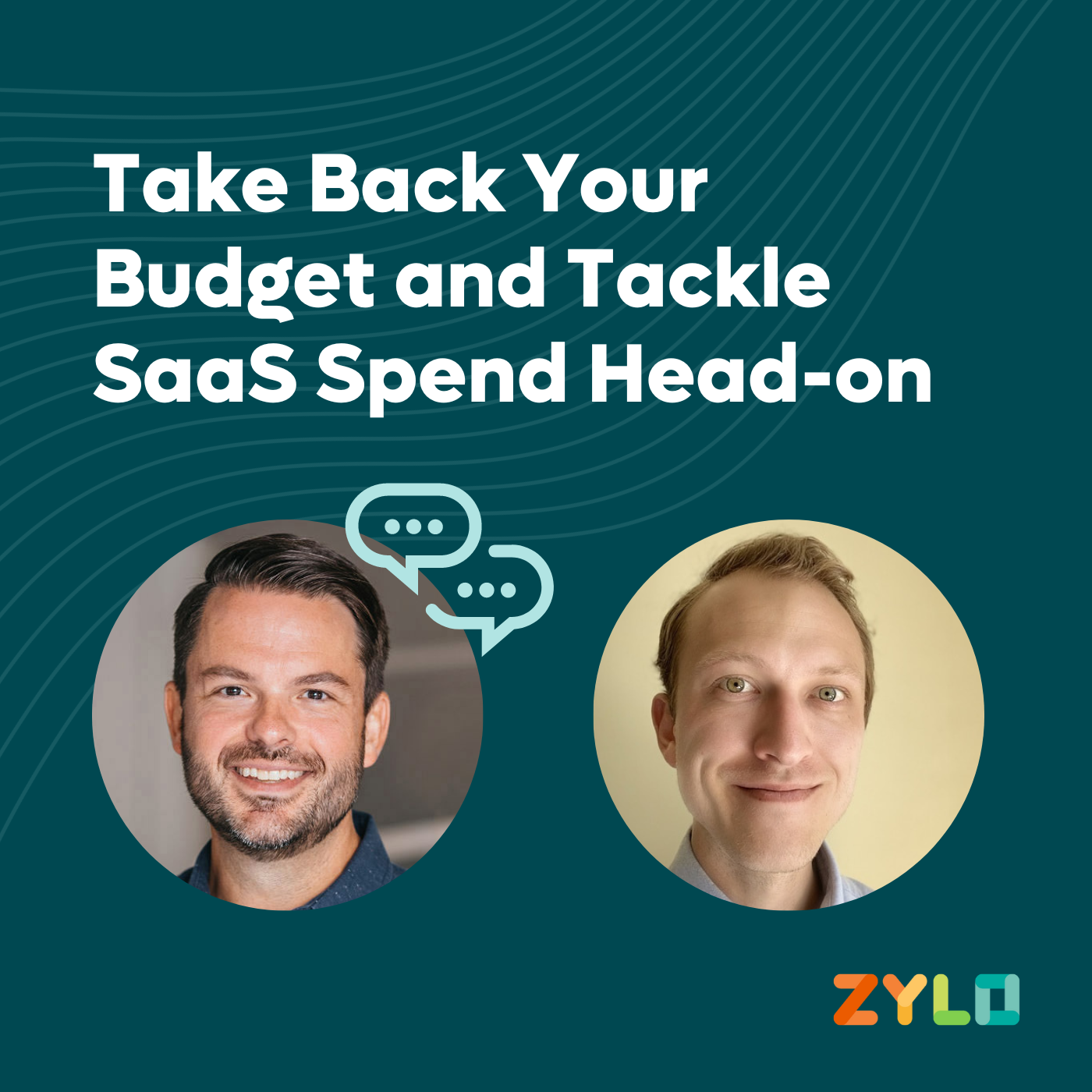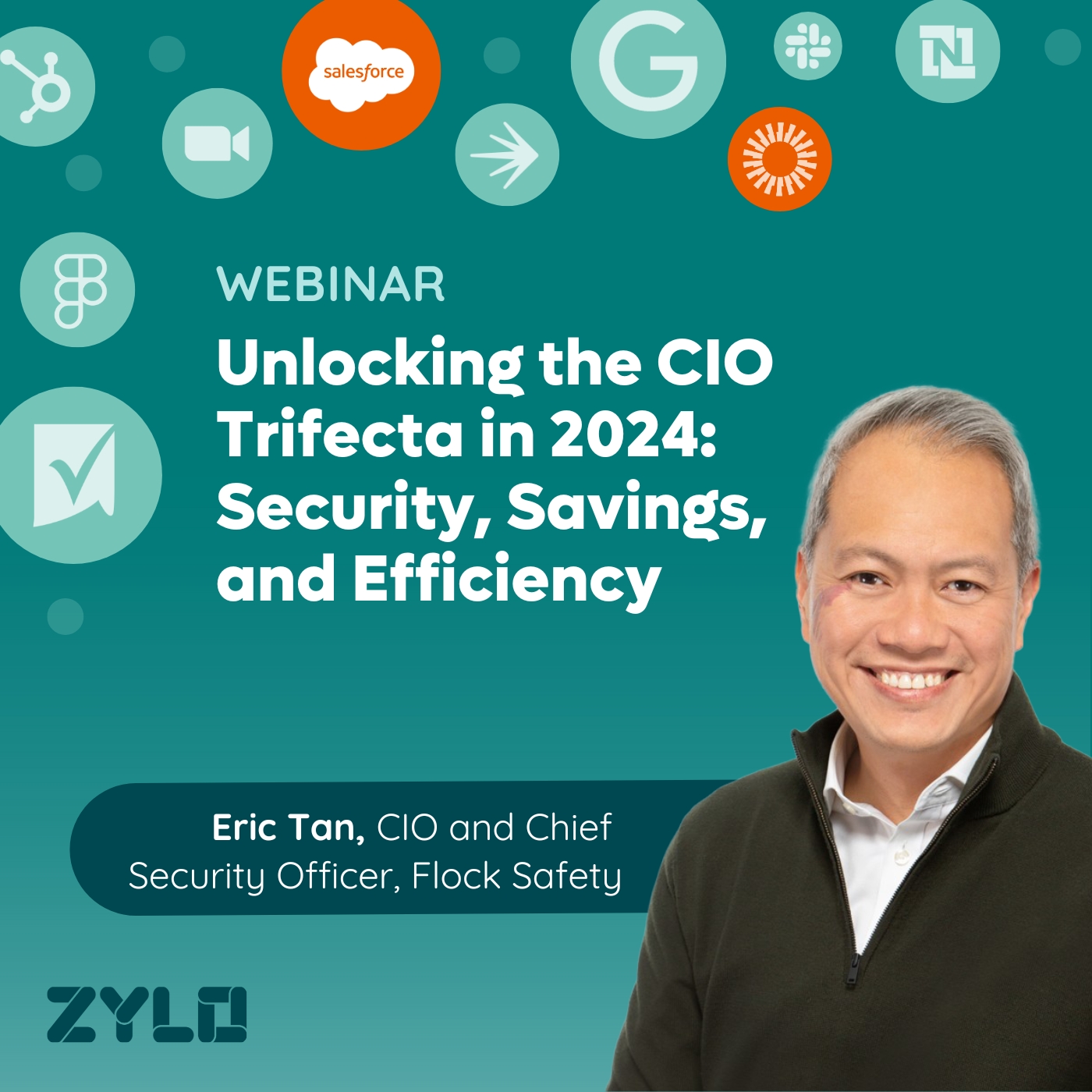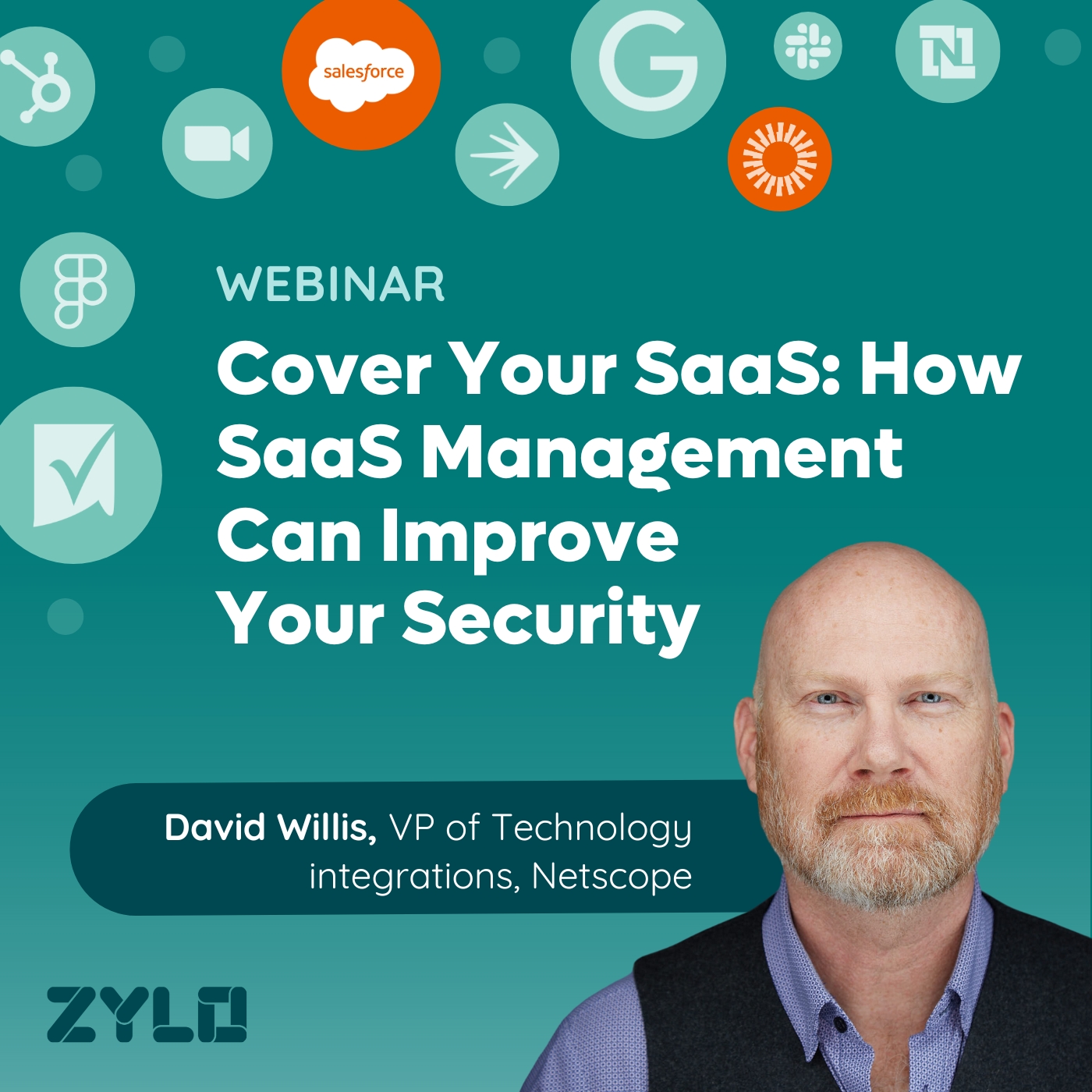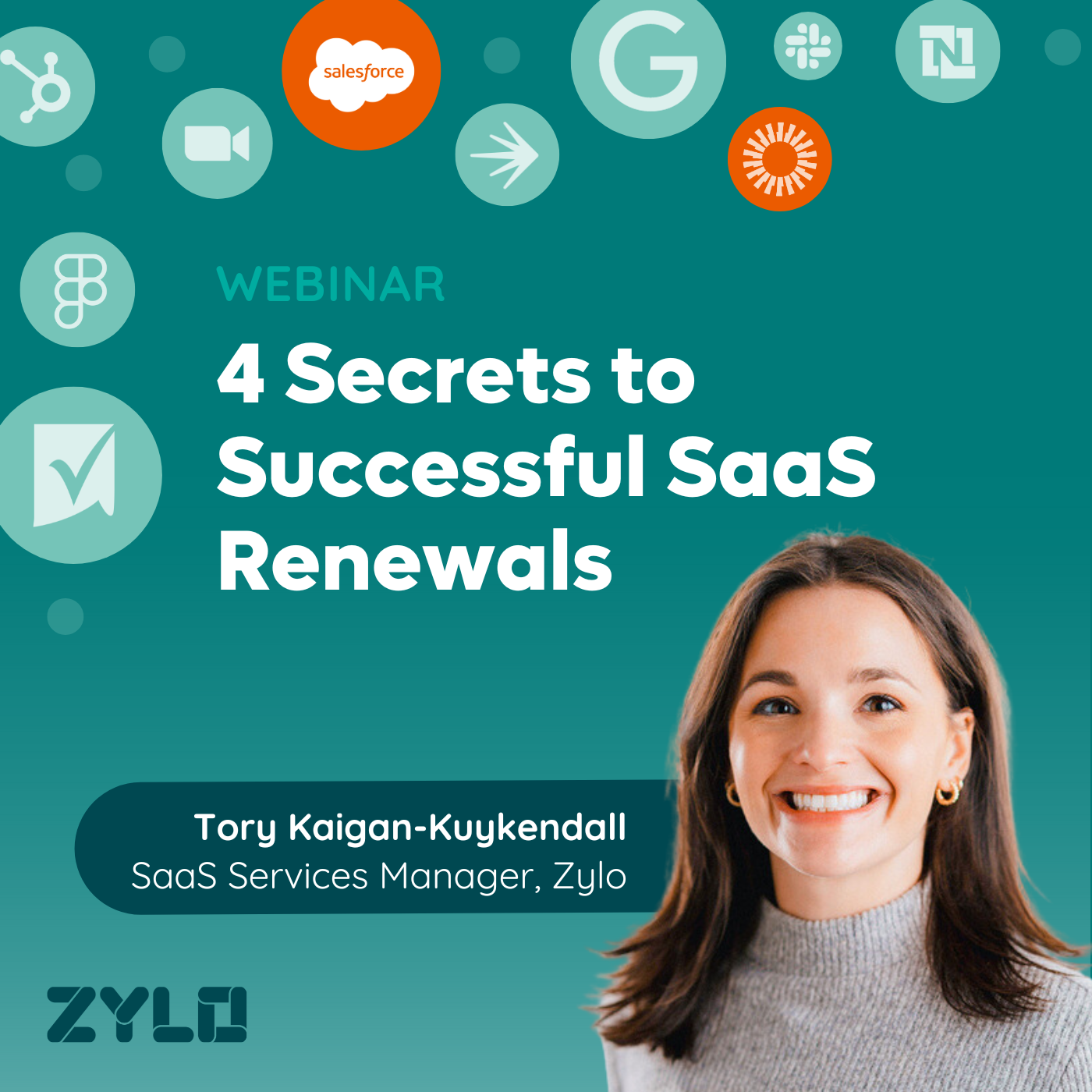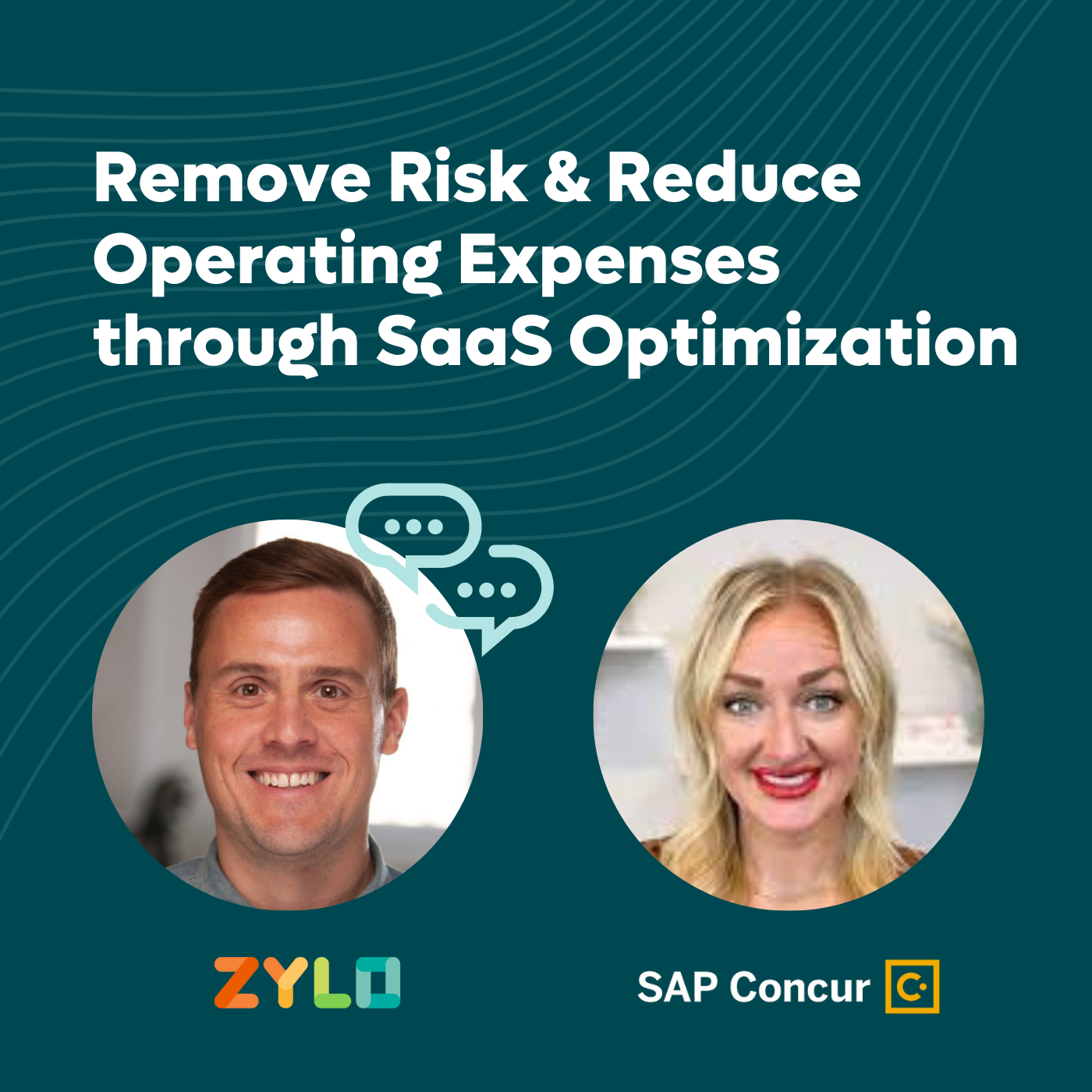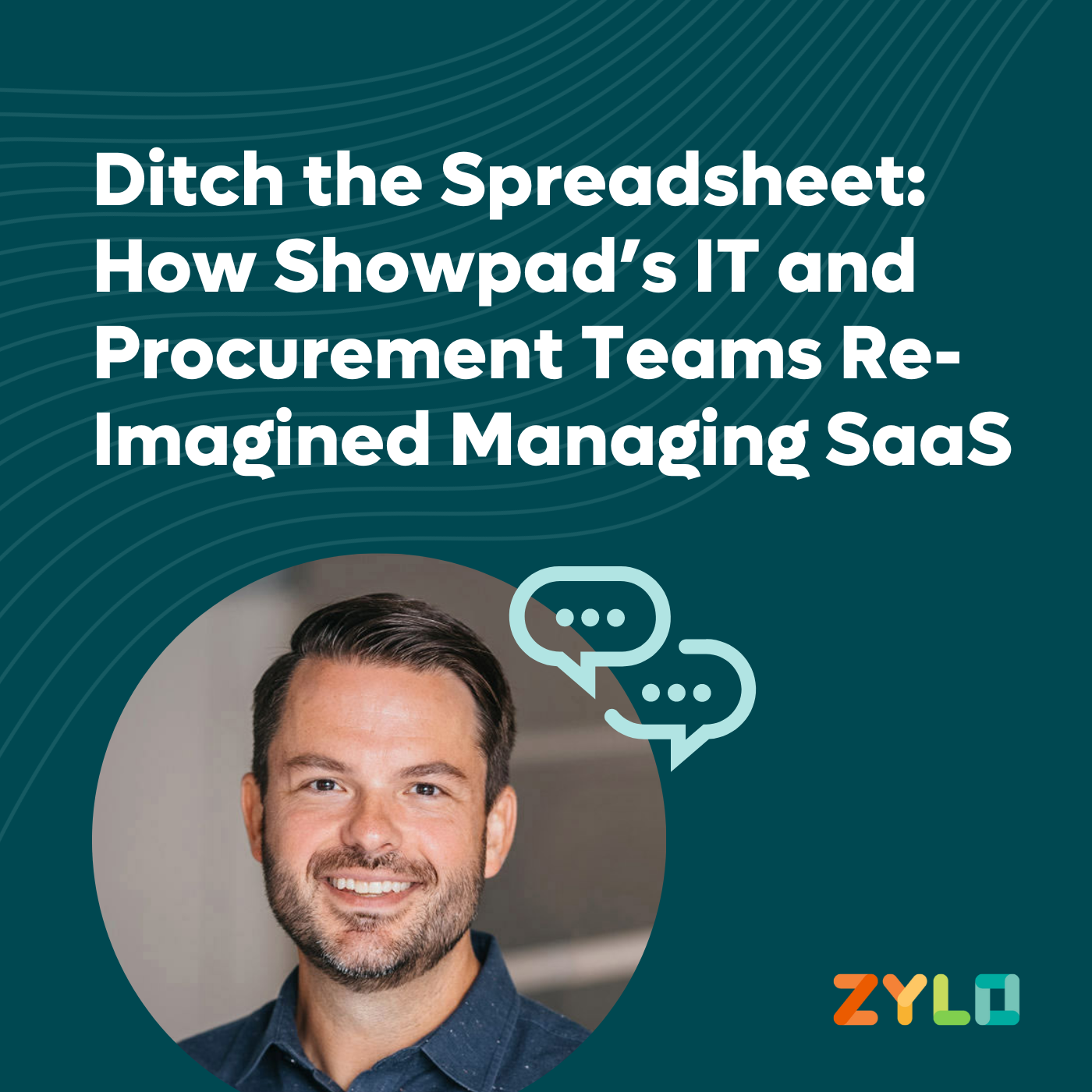Take Back Your Budget and Tackle SaaS Spend Head-On
- 0.5
- 1
- 1.25
- 1.5
- 1.75
- 2
Cory Wheeler: Let's jump in and get started. Thanks to everyone for joining us today for today's webinar, Taking Back Your Budget and Tackling SaaS Spend Head On. Really quick introductions today before we jump in and get started. I'm Cory Wheeler, the chief customer officer and co- founder here at Zylo. I have the great pleasure of working with our customer base today on implementing SaaS management methodologies, driving SaaS optimization across their stack and overall reigning in the chaos of SaaS today. And I'm joined by Chase. Chase?
Chase Thompson: Yeah. Thanks, Cory. Hi, I'm Chase Thompson, director of product management here at Zylo. I focus on our entire core application experience and I have a background in software asset management. Really excited to chat with you all today.
Cory Wheeler: All right, so really quickly want to set the agenda that we're going to be walking through today. We're going to set up the stage for SaaS today and the state of SaaS growth and really how we think about moving forward as we're also going through some uncertain economic times. How do those converge together around the concept of SaaS budgeting? It's very topical across our customer base today. We're going to walk into kind of those core components of better budgeting, then talk about how we really bridge the gap and bring those better budgeting tips together with being able to really manage your stack with Zylo and budgeting in an up- leveled way. Chase is going to then walk us through some use cases around budgeting and then do a live demo of our budgeting product directly in Zylo. And then we'll save time at the very end for some Q& A, so feel free to drop those into the chat. If you've got any questions, definitely jump in there. We'll get to as many of those questions as we can today during the live session. And just one more item to keep aware of, we are recording today's webinar, so you'll receive the link to the recording about a day, maybe two days after today's event. So you can go back and re- watch, share with other team members and definitely have this content on hand. Well, let's get into it. I want to start off framing out the state of SaaS spend today. Zylo's got our finger on the pulse of SaaS and the growth and potentially the lack of growth in SaaS over time. Over the last six and a half years, we've built up a SaaS database that today we're currently managing right around$ 30 billion in SaaS expenses in Zylo and over time, much larger than that. When we start to look at that and we start to marry that with some of the analysts that we speak with on a pretty regular basis, the first thing that's standing out to us as we go into the back half of this year is that Gartner is very clearly predicting growth in SaaS. 19% predicted growth, 22 to 23 in annual SaaS expenditures. Now, when we start to talk to our customers and we're looking at budgets and we're assessing where those optimization opportunities are, there are definitely a lot of organizations right now that are in the middle of budget season, in the middle of flattening or reducing those overall budget dollars. But when you look at 19% growth year- over- year, you really understand why across our customer base as well, OPEX, within the OPEX line item, SaaS is that second largest line item today, right behind headcount. And when we think about the OPEX expenditures inside your business and how to explain some of that, well, what we know is a lot of SaaS that we see still continuing to grow is really replacing a lot of that headcount that is flat or reduced. As hiring freezes are in place and that's been the last quarter or two, as layoffs are in place, technology is replacing automating and making more efficient what would've been a headcount or resource in previous years. And so as we start to think about that and contextualize what that means for SaaS budgets, that is very, very clear. Most budgets today are flat. Some are reducing, economic uncertainty as everybody tightening their belts. A lot of tech forward and tech organizations are really pivoting from growth at all costs to the right foundational metrics, a path to profitability. So we've really got the convergence of tech driving more mature practices and more pragmatic practices with other industries that are continuing to drive that similar approach and always have. Profitability is a must. But with rising OPEX, you've got to put that in context. Today, the question that we get from our customers is, do we hire more heads or do we bring on more SaaS technology? And something has to give, and there are trade- offs as you're looking at how that budget is impacted. But we know that SaaS is here to stay, and that's not a self- serving statement. What that is, is knowledge that work takes place in SaaS. Conferencing solutions, communication, project management, all of that is driving efficiency for our customers with their workforce today. And so SaaS is here to stay and to grow. We will definitely see a lot of changes in the market, maybe M& A and a lot of those applications potentially becoming suites more so than point solutions, that remains to be seen. But what we know today is that SaaS is continuing to power the employee experience. But there's probably no one out there that says that SaaS budgeting is not hard. It is very difficult. Finding SaaS is difficult. Understanding where it is in your organization, that extends all the way through budgeting. And that's fundamentally because of the three sort of high- level themes that I'm outlining today. One, there is an immediate and clear disconnect between IT leadership, finance leadership, and the line of business owners within an organization. Typically, finance teams struggle to get visibility into application- level budgeting. They're building prepaid reports. Those prepaid reports are growing as they're tightening that reporting going forward. And so historically, they've pulled a lot of detail around the biggest applications but missed out on a lot of the sprawl of applications. And as we know at Zylo, the sprawl of applications also includes different ways in which software is purchased. Very common use case that we hear within our customers is a finance team coming to the line of business and saying, " You're over budget in quarter three. You have no budget available. Why weren't we aware of this?" Well, there's a lot of reasons why and we'll walk through that. Other customers are still managing these budgets directly in spreadsheets. And when you think about the budget versus the actual spend, spend comes through with an application. Budgeting is done at the application level as well, but sometimes budgeting is done a little bit higher level than that. So being able to bring IT, finance, and your line of business leaders together to drive budgeting is a must. When you think about the budget versus actuals, I mentioned the Q3 example. This is a very time- intensive process. And finance teams are caught by surprise by budget overages. That could be true- ups, that could be add- on licensing, that could be consumption level, usage of an application that was unplanned for, and there's an entire market around being able to optimize that. But budget versus actual is the critical need. It's that first step to be able to understand what you budgeted for an application and then be able to see how that is tracking and trending over time. Those overages for add- on licenses and consumption are not accounted for in most budget planning processes. That's a really important point. The worst thing for any finance leader is a surprise to a budget, to go back and have to update those budgets and update the actuals to reflect what that expense is going to be throughout the remainder of the year. That variability is something that has been a struggle for SaaS with finance teams and IT over the last 20 years. So how do you drive better budgeting, overall better budgeting? When we think about that, you've really got to understand what your SaaS stack looks like today, and there's a lot that goes into that. That is certainly an inventory, a comprehensive inventory of every application that you've got. Within that application inventory, you'll have many different lines of business, employees and departments that are purchasing similar software. One of the core components that we always look at is leverage across the company. Where do you have spend with a large provider across multiple business units with employees expensing the same software? What does that inventory look like and what's that inventory made up of? Those sources of spending will highlight those areas that are outside of your budget. Things like that, employee expensed applications, your shadow IT that are really unaccounted for, or maybe a smaller use case with a secondary cost center that creates a budget overage as they go through the year and execute their overall strategies. High spend applications, you've got to understand those. The ones that have high transactions day after day, week after week and month after month. It's not just a single purchase, it is ongoing purchases that extend your budgets beyond what you plan for. Contractual price increases. We talk with a lot of finance leaders that will take existing spend or existing contract data and then just re- up that in the next year because they don't have visibility into what these triggers are that are going to happen each year. Contractual price increases must be tracked, must be budgeted for or before you even begin your year, you are planning to be over budget. And those growth and retraction trends in your employees, your headcount, your overall organization are critical to understand as well. So over the next year to two years, are you growing 10% to 20% from a headcount perspective or are you pulling back on headcount? Do you have flat or reduced budgets going forward? So how well do you need to budget? We started Zylo back in 2016. Budgeting was certainly out there as a question that a lot of folks raised to us. But times were pretty good, so there was a little more forgiveness as you extend beyond budgets and extra additional budget availability. Well, that all ended earlier this year as RIFs and budgets started to be put in motion. So the leeway on going over budget, there's a much tighter scrutiny from your finance team around that today. And then other companies that are looking at M& A. When you're bringing in acquired entities, when you're bringing in software, how many employees, what's that going to do to your overall license count and consumption metrics that drive to that total cost for that application? You've got to understand what that looks like in your organization. 19% is surprising, but when you look at the underlying reasons why 19% growth in SaaS is predicted by Gartner based on their data, it makes sense. If you're not bringing on additional employees, you still have to do more with less. The very first place you turn is automation and tooling to be able to create efficiencies inside your business. So from that, there is definitely something missing. What is it? It is being able to centrally understand all of your SaaS and plan for it accordingly. And that includes a single source of truth for SaaS. And that single source is a centralized solution where finance, IT, your line of business, everyone is singing off the same song sheet. They understand the expenses, they understand the liabilities and the purchase orders that are extended, and then they are able to now understand what budgets look like. So you've got to be able to get that full discovery categorization around all of your applications. The metadata and the additional information tracked in there for finance, IT, and lines of business. Pull in the actuals, the cost and spend details. It is very, very common that a single application will have many cost centers, many individuals, all purchasing the same or similar software that you've got to be able to leverage together when you're looking at a single budget line item. You've got to look at those licenses, entitlements, and overall features because that rightsizing is done throughout the year. That's typically a true- up or an increase of licenses needed for new stakeholders. You've got to look at what those will do once you start to onboard new employees, or bring new employees into an application that's already on site. You've got to look at the term and renewal information. The renewal will be that pricing event that changes throughout the year. We see this a lot. We've budgeted for the existing pricing structure. Your renewal is mid- year, the pricing structure increases, and surprise, you've got a budget that you're already exceeding or planning on exceeding six months into the year. And finally, ownership information. Finance needs this information, IT needs this information. At Zylo, we feel very, very strongly that the management of software as a service is a team sport. It is IT owning the adoption and the value of applications and really owning the risk and the mitigation around that for their company. But on the finance side, procurement teams are there to no doubt drive optimization at every renewal, operationalize every single renewal. So understanding the owner, the third piece of that puzzle, bringing them into the renewal, the negotiation around that, the optimization of it and the budgeting of it now makes you a much more proactive SaaS management professional as you're building out this practice internally. You've got to then take that centralized solution and be able to pull insights together to get to that budgeting outcome as well. You're monitoring license usage. The number one reason that we see that budgets are extended are new license requests. But at the same time, you've got to be able to pull back licenses that aren't being leveraged today. A typical Zylo customer across our data set, we see up to 40% of inactive license usage across their stack. So before you're buying new applications, you're running a license reclamation workflow to pull back those licenses that aren't being leveraged today. That is how you can proactively stay under budget, stay under that forecast and reallocate those licenses. A lot of our customers are then turning to rationalization, looking at functional overlap, the demand management step of, do we need to renew this application? I see in my SaaS management solution in Zylo that we have 12 other project management solutions where we know budgets are tight, we know budgets are down. Now is the time where demand management, and the confidence of making an application rationalization decision is upon us. So that step is critical to being able to drive to a budget outcome. And then leveraging benchmarking data. Ahead of your next renewal, are you getting the right price? You've already looked at your licenses, now look at that price point. Pull in the benchmarking detail and forecast where you might be able to drive that optimization, hold your budget flat or even potentially bring that down. Planning, managing and tracking your budget. Thinking about how we've built this at Zylo, and we're all pretty fortunate to have Chase joining us today to run through this. But those are the core concepts that we think about for budgeting and forecasting across our customer base. Take those data driven insights, inform forecasting, execute on your cost optimization targets, and then track those actuals and budget. For our customers that leverage our PO solution, track your liabilities. We've got actuals. We've got the liabilities that you've extended out for the year and then track that to those actuals. Our Coupa PO integration really allows you to be able to see actuals, the prediction, and then the budget and tie all three of those together, and then very clearly and very quickly learn when any of those are out of line because you've got to make those adjustments mid- year. You can't get near the end of the year and go to finance and say, " Sorry about that." I think that's the problem that we've seen today in the mantra of SaaS's chaos. So that's data- driven execution to put a bow on this, to handle that OPEX reduction, to be able to manage that to your budget. Looking at those redundancies, looking at duplicate purchases, shadow IT, sprawled purchases for the same apps. Looking at the adoption of those apps and pulling back licenses and overall consumption where needed. And to do that, you've got to have centralized data. And how do we ace our SaaS budgeting game with Zylo? I would love to turn it over at this point to Chase to jump in and provide an overview.
Chase Thompson: Awesome. Thank you, Cory. A lot of great information there. So I'm going to go ahead and take us through how we put this into practice. So I'm going to start off with just a quote here. Take a moment to read that. The punchline here is that a lot of the billing models for SaaS can actually lead to costs that are growing faster than you plant. And we see this over and over again. There are kind of two layers to this. So on the one hand, there's a lot more SaaS out there than you might be expecting. This is a pattern that repeats itself for all of our customers. They come in thinking they have 50, maybe 100, maybe 200 applications and end up finding 500 or a thousand or more depending on the size of the business. And for each of those applications, you may be budgeting really well for some of the big ones. But that long tail that Cory was talking about is where costs grow exponentially and much faster than planned. Nobody's taking a close look at those. The thing about SaaS is a lot of the billing models lead to growth very tightly aligned to usage. And usage can take off from just a few core users, kind of expands organically. The next thing you know, you've got a very big uptick and spend that you did not plan for. And you scale that up to 500 or a thousand apps, the dollars really add up. So let's go ahead and look at some real world use cases and then I'm going to jump into a demo here in a few minutes. So taking a step back at the core of Zylo's platform, you're really setting up a comprehensive SaaS system of record. That's payment data, contract data, HR data, usage and consumption data. And now budget and forecast data as well, really to bring all that together for the IT and finance perspective. Layered on top of all of that data, Zylo is providing insights that drive you towards valuable action. These insights have a pretty big scope and then sometimes a really granular scope. Some of those insights are how are you doing at a portfolio level? Where should you look to make changes? Other insights are granular per app optimization opportunities or budget insights, budget opportunities. Where do you have chance to make efficient cuts or to grow the right way? So we start to look at the spend management and reporting side of things, and we have insights actually on payment data, brand new insights on budget. I'm going to show some of that in the application. And with all of this data and these insights, you, whether you're IT or an app owner, maybe both, software asset manager, you have the opportunity to actually inform forecasting based on all of those inputs. And that's where Zylo provides a really strategic advantage. You need a SaaS system of record to accurately forecast for SaaS. No other collection of data could really get you to that point of forecasting appropriately. So then let's say you have all that data, you have all your insights. What are you going to do to actually take action? Let's imagine for a second, you've got your budget set, you're starting a new fiscal year. By default, the entire experience of identifying over or underspend is actually very reactive. And we've taken a look at this and said, " How can we get just a bit more proactive for managing spend versus actual throughout the year, really set up IT to be a more strategic input to finance and set up for a more proactive budgeting season?" That's our entire goal here, to really strengthen that partnership, make it more proactive, stop getting caught on your heels. So throughout the year, kind of thinking about that Q3 example, insights in Zylo are going to help identify where you may need to work with an app owner. Maybe that's you to request more budget or ideally look for budget. And this is a little bit of the rebalancing, the reshuffling that Zylo specifically can help with from a SaaS perspective. Just to drill in on that example a little bit. In a lot of cases, our most successful customers are actually sort of reshuffling things. Let's say you're running quite hot on consumption or usage for one application. Your costs are increasing way past what you expected. Well, a lot of times there's probably the inverse case out there somewhere. So without Zylo, the reaction might be, " Ah, we have to increase our spend, we need more budget. Let's go talk to finance." Well, with Zylo, you could actually take a pause, look for where your underspending, or even within that application, you have licenses available. And Cory touched on this a bit. I'm going to show an example of this, but you can run really tight software hygiene with Zylo where you're constantly reshuffling those inactive users, their licenses to new users or users who need an increased license. And that's going to delay or even completely avoid add- on purchases, which is a huge win. It drives big cost avoidance throughout the year because IT or software asset manager was able to sit in a proactive position using Zylo data. The bottom line throughout all of this is really that continuity of service. To the end user, a lot of times, we're kind of invisible. If we're doing our job right, they have the tools to get their job done, and at the end of the day, you've actually helped the business do more with less, which is always a beautiful thing. The last use case here before I get into a demo, a little bit about that long tail of spend. So Zylo is really uniquely positioned to actually understand this huge bucket of SaaS and these applications that are just being thrown into G& A sort of recklessly, because it looks small. Well, we can just put in G& A. It doesn't have a home, doesn't have a budget owner. That really piles up when you're talking about 500 plus applications. And SaaS is a huge culprit here for something that starts as G& A, spirals into this massively expensive app that's out of control, nobody's responsible. Since Zylo starts by discovering all SaaS comprehensively, you're going to be able to identify every single application that hasn't made it into the budget. And then from there, use a lot of the other data in Zylo to prioritize, " Okay, let's get a plan to work this into budget," or at least be aware of it on some level. Maybe there's a threshold that needs to cross before you assign an owner and work into budget for next year. But at a minimum, you're tracking that. You're kind of putting a number and a name on it so you understand, " Hey, this long tail, it's actually 10, 20 million dollars in total is probably a lot of efficiency here if we need to take a look." Getting your arms around all this unmanaged spend, the other thing you're often going to find is that there's just these orphaned or redundant apps that are sort of on the running. Somebody was using them, but they're completely out of use now. And there might be this kind of recurring payment happening where IT thinks, " Oh yeah, marketing's still using that." In reality, with Zylo data, you can take a look and say nobody's actually using that. It's maybe one or two logins per month. We should really evaluate dropping this off completely and sunsetting this application. Finding those opportunities within the long tail is really where Zylo can help you excel.
DESCRIPTION
Inflation, layoffs, and budget cuts, oh my! It’s become increasingly clear the world is feeling the effects of a global recession. How deep and how long it’ll last is anyone’s guess. What we do know is this: Every business is looking at their operating expenses with more scrutiny.
And it’s understandable. The average company spends $65 million a year on SaaS. In fact, it’s likely the number two line item in your budget next to employees.
You can’t afford not to budget accurately. It’s vital to understand what your tools are going to cost, where you can save money, and how your actual spend is tracking against your budget.
Join Cory Wheeler and Chase Thompson for a discussion on the state of SaaS in 2022, and how to take charge of your budget with Zylo.
Webinar Highlights:
- [00:03 - 01:45] Webinar Intro & Goals
- [02:19 - 04:13] Framing the state of SaaS today in 2022
- [04:14 - 05:46] Flat budgets and the efficacy driven by SaaS
- [05:46 - 11:12] A disconnect between IT leadership and finance leadership
- [11:14 - 14:36] Communication and unification between leadership, greater insight into purchasing and budgets
- [14:37 - 16:08] A typical Zylo customer has 40% inactive licenses that aren't being leveraged
- [16:15 - 17:36] Core concepts and successes of Zylo customers
- [17:52 - 19:14] SaaS costs can add up fast
- [19:15 - 20:49] Zylo's platform and insights
- [20:52 - 21:55] Taking action from insights
- [21:58 - 23:23] Tight software hygiene with Zylo
- [23:32 - 25:25] Ownership and identifying software spend limits and triggers
Today's Guests

Cory Wheeler


